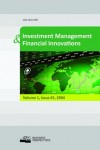Are key market players in currency derivatives markets affected by financial conditions?
Are key market players in currency derivatives markets affected by financial conditions?
Author(s): Ikhlaas GurribSubject(s): Economy, Transformation Period (1990 - 2010), Present Times (2010 - today), Financial Markets, Fiscal Politics / Budgeting
Published by: ТОВ “Консалтингово-видавнича компанія “Ділові перспективи”
Keywords: hedgers; speculators; net positions; foreign currency futures; financial conditions indices;
Summary/Abstract: This study investigates if the biggest players in major foreign currencies futures markets are affected by current and previous financial conditions. Using root mean squared errors (RMSE), normalized RMSE, and Nash-Sutcliffe efficiency, this study compares the impact of current, 1 and 2 week lags of financial conditions onto foreign currency futures players’ net positions. The financial conditions indices used are UFCI, STLFSI, NFCI and ANFCI with weekly data set from January 2007 till December 2018. The US dollar index futures is included as a benchmark, since the financial conditions are based on US data and the most actively traded foreign currencies are paired against the USD. While RMSE and NRMSE gave mixed results into how current, 1 week and 2 weeks lagged Financial Conditions Indices (FCIs) values are related to speculators and hedgers’ net positions, lagged NFCI captured the highest correlation with both players’ net positions in Japanese Yen. 95% prediction levels encompassed the actual net positions held, including the financial crisis of 2008–2009. Forecasts were lower (higher) for hedgers (speculators) than actual net positions held during the same period. Comparatively, in the period 2016–2017, hedgers (speculators) net positions forecasts were higher (lower) than actual positions. The latter could be explained by FCIs not being affected during this period’s event, compared to net positions. While net positions data were stationary, excess kurtosis was present pointing to non-normal and auto-correlated series. This suggests the need to look into other components like non-reportable long or short positions in future analysis.
Journal: Investment Management and Financial Innovations
- Issue Year: 15/2018
- Issue No: 2
- Page Range: 183-193
- Page Count: 11
- Language: English

